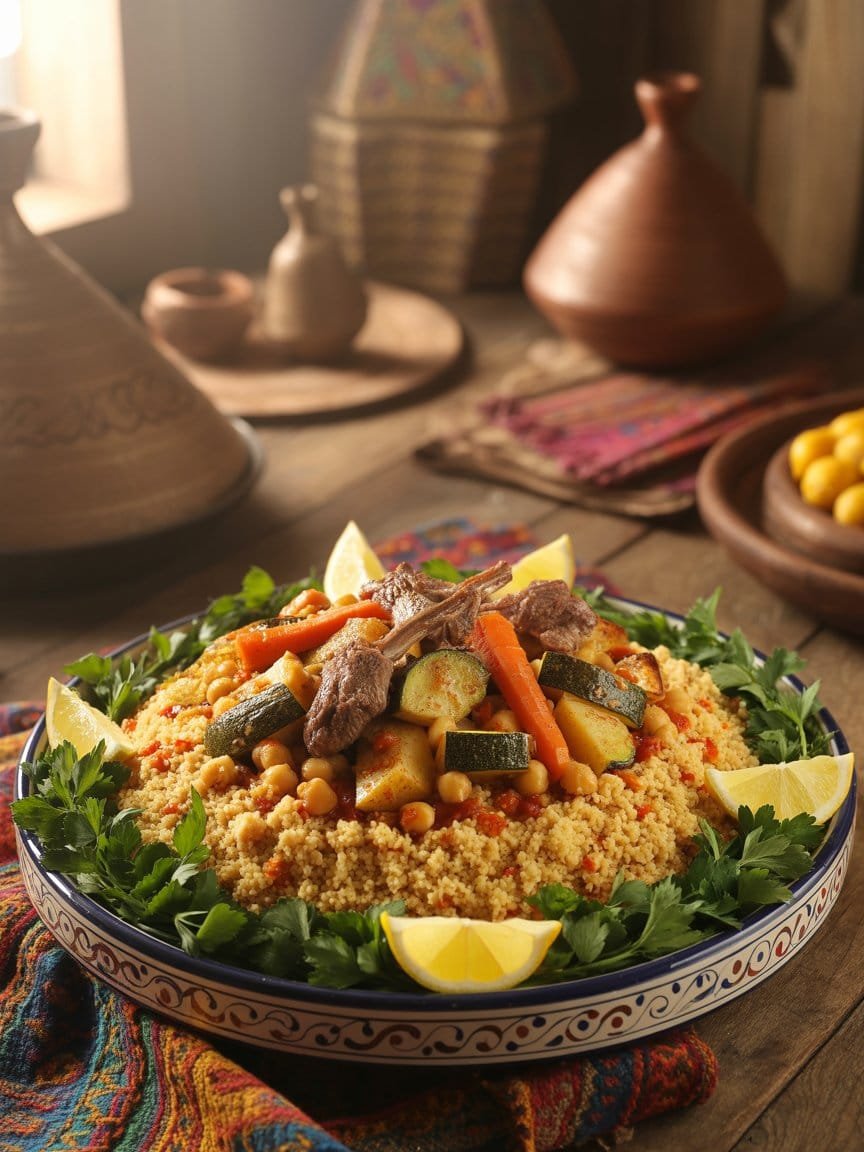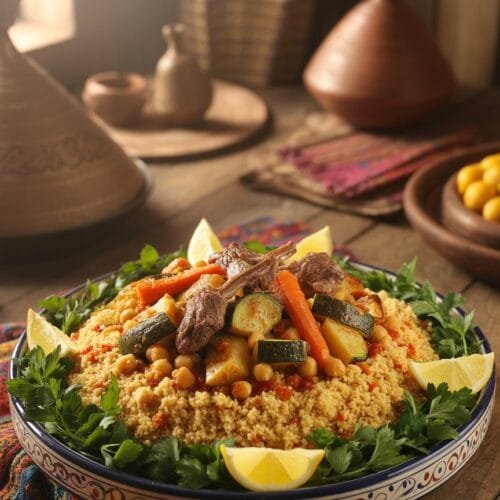Tunisian Couscous with Meat and Vegetables Recipe

As a professional chef, few dishes excite me quite like a traditional Tunisian Couscous with Meat and Vegetables. This iconic North African recipe isn’t just a meal—it’s a celebration of culture, flavor, and culinary craftsmanship. Rich in warming spices, vibrant with colorful vegetables, and deeply comforting thanks to tender meat and fluffy couscous, this dish is an experience every food lover deserves to savor.
Whether you’re already familiar with couscous or new to the North African culinary scene, this guide will walk you through everything you need to know to recreate an authentic Tunisian couscous at home. From carefully selected ingredients to time-honored techniques, we’ll dive deep into the essence of this beloved dish. So, let’s roll up our sleeves and bring the magic of Tunisia into your kitchen.
What Is Tunisian Couscous with Meat and Vegetables?
Tunisian couscous is a complete meal layered with aromatic spices, slow-simmered meats (commonly lamb, beef, or chicken), and an array of seasonal vegetables like carrots, zucchini, potatoes, and chickpeas. It’s all brought together over a bed of light, steamed couscous that soaks up the rich, savory broth.
While couscous is enjoyed across the Maghreb—from Algeria to Morocco—Tunisian couscous has a distinct character. It’s spicier than its Moroccan cousin and often includes tomato paste and the ever-present Tunisian chili paste harissa, which gives the dish its signature warmth.
Ingredients for Tunisian Couscous with Meat and Vegetables
To make a traditional Tunisian couscous, you’ll need a mix of pantry staples, fresh vegetables, and high-quality meat. Here’s a detailed list:
For the Couscous Base:
- 2 cups medium-grain couscous
- 2 tbsp olive oil or melted butter
- 1 tsp salt
- 1 ½ cups warm water (plus extra for steaming)
For the Meat & Vegetable Stew:
- 2 tbsp olive oil
- 2 medium onions, finely chopped
- 3–4 garlic cloves, minced
- 1½ lbs lamb shoulder or beef chuck, cut into chunks (or use bone-in chicken pieces)
- 2 tbsp tomato paste
- 1 tbsp harissa (adjust to taste)
- 1 tsp ground coriander
- 1 tsp ground cumin
- 1 tsp paprika
- ½ tsp ground cinnamon
- Salt and black pepper to taste
- 4 cups water or broth (beef or chicken)
Vegetables:
- 2 carrots, peeled and halved
- 2 zucchini, halved lengthwise
- 2 potatoes, peeled and quartered
- 1 cup pumpkin or squash, chopped into chunks
- 1 can chickpeas (or 1 cup cooked)
- 1 bell pepper (optional), quartered
- 1 small cabbage (optional), quartered
Step-by-Step Preparation Guide
Step 1: Season and Sear the Meat
- In a large heavy-bottomed pot or couscoussier (traditional couscous steamer), heat olive oil over medium heat.
- Add the chopped onions and cook until soft and translucent.
- Stir in the garlic, followed by your meat of choice. Brown the meat on all sides to seal in flavor.
- Add the tomato paste and harissa. Stir to coat the meat thoroughly and cook for 2–3 minutes until fragrant.
Step 2: Build the Stew
- Add all the ground spices (coriander, cumin, paprika, cinnamon) along with salt and pepper.
- Pour in the water or broth, bring to a boil, then reduce the heat to a gentle simmer.
- Cover and simmer for 30 minutes to let the meat begin to tenderize.
Step 3: Add the Vegetables
- Begin by adding denser vegetables like carrots and potatoes.
- After 10 minutes, add zucchini, pumpkin, and bell pepper.
- Stir in chickpeas and cabbage last to avoid overcooking.
- Simmer until all vegetables are fork-tender and the meat is meltingly soft (total stew time: about 1.5–2 hours).
Step 4: Prepare the Couscous
While the stew simmers, let’s steam the couscous the traditional way:
- Place couscous in a large bowl, drizzle with olive oil, and sprinkle salt.
- Gradually add warm water and fluff with fingers or a fork until evenly moistened. Let sit for 10 minutes.
- Transfer to a steamer basket or colander over boiling water and steam for 15 minutes.
- Return to the bowl, fluff again, and sprinkle with more water. Repeat steaming and fluffing 2 more times for the best texture.
(Chef’s Tip: If you’re short on time, use instant couscous per package instructions—but steaming brings out a much superior texture.)
Chef’s Pro Tips for Perfect Tunisian Couscous
- Use bone-in meat: It adds depth and richness to the broth.
- Don’t rush the steam: Proper couscous should be light, fluffy, and never gummy. The multi-step steaming process is worth the time.
- Balance your harissa: Tunisian cuisine is known for its heat, but always adjust according to your spice tolerance.
- Layer flavors: Frying the tomato paste and harissa with meat intensifies the savory base.
- Add a dash of lemon juice: Just before serving, a little acidity brings the dish to life.
Recipe Variations
Chicken Couscous
Swap lamb for bone-in chicken thighs or drumsticks. The lighter flavor works beautifully with vegetables and absorbs the spicy broth quickly.
Vegetarian Couscous
Omit the meat and use vegetable broth. Load up on legumes and seasonal vegetables. Add chickpeas, turnips, sweet potatoes, or even artichoke hearts for complexity.
Couscous with Fish
A coastal Tunisian twist: use firm white fish like sea bass or grouper. The broth will be lighter, and harissa becomes the star of the flavor profile.
How to Serve Tunisian Couscous
Presentation is everything with a dish as grand as this. Here’s how to make it shine:
- Arrange the couscous in a large serving platter, mounded in the center.
- Create a well in the middle and spoon the meat and vegetables generously over the couscous.
- Ladle some broth around the edges so the grains stay moist, not soggy.
- Serve the extra broth in a bowl on the side for guests to add as desired.
- Garnish with chopped fresh parsley, lemon wedges, or even hard-boiled eggs (a Tunisian tradition!).
Suggested Side Dishes and Accompaniments
To complete your North African feast, consider the following:
- Brik à l’œuf (Tunisian egg pastry)
- Fresh harissa on the side for those who love extra spice
- Cucumber and yogurt salad for a cooling contrast
- Mint tea or rosewater lemonade for a refreshing beverage pairing
Storing & Reheating Leftovers
Tunisian couscous stores incredibly well:
- Refrigerate leftovers in airtight containers for up to 4 days.
- Reheat couscous separately by steaming or microwaving with a splash of water to restore fluffiness.
- Freeze the stew (meat and vegetables) for up to 3 months. Couscous doesn’t freeze as well, so make fresh when needed.
The Cultural Significance of Couscous in Tunisia
In Tunisia, couscous isn’t just food—it’s tradition. It’s made for Friday family gatherings, weddings, and festive holidays. Each region has its own variation: some coastal towns add seafood, while inland areas favor heartier meat versions. The ritual of preparing couscous—fluffing, steaming, and savoring—brings generations together. Recreating this recipe at home offers a taste of that warmth and unity.
Final Thoughts on Making Tunisian Couscous with Meat and Vegetables
This Tunisian Couscous with Meat and Vegetables recipe is more than just a dish; it’s an immersive experience in North African comfort food. It embodies balance—between spice and sweetness, tradition and creativity, community and comfort.
Whether you’re exploring Tunisian cuisine for the first time or returning to familiar flavors, this recipe will reward your effort with a soul-satisfying meal. So, gather your ingredients, take your time, and enjoy the rich aromas as they fill your kitchen.

Tunisian Couscous with Meat and Vegetables Recipe
Ingredients
For the Couscous:
- 2 cups medium-grain couscous
- 2 tbsp olive oil or melted butter
- 1 tsp salt
- 1½ cups warm water plus more for steaming
For the Meat & Stew Base:
- 2 tbsp olive oil
- 2 medium onions finely chopped
- 3 –4 garlic cloves minced
- 1½ lbs lamb shoulder beef chuck, or bone-in chicken
- 2 tbsp tomato paste
- 1 tbsp harissa adjust to taste
- 1 tsp ground coriander
- 1 tsp ground cumin
- 1 tsp paprika
- ½ tsp ground cinnamon
- Salt and black pepper to taste
- 4 cups water or broth chicken or beef
Vegetables:
- 2 carrots peeled and halved
- 2 zucchini halved lengthwise
- 2 potatoes peeled and quartered
- 1 cup pumpkin or squash cut into chunks
- 1 can chickpeas or 1 cup cooked
- 1 bell pepper optional, quartered
- 1 small cabbage optional, quartered
Instructions
Step 1 – Sear the Meat:
- Heat olive oil in a large pot or couscoussier over medium heat.
- Add onions and sauté until soft.
- Stir in garlic and meat. Sear until browned on all sides.
Step 2 – Build the Stew:
- Add tomato paste and harissa. Cook for 2–3 minutes.
- Stir in spices (coriander, cumin, paprika, cinnamon) and season with salt and pepper.
- Pour in broth or water. Bring to a boil, then reduce heat to simmer for 30 minutes.
Step 3 – Add the Vegetables:
- Add carrots and potatoes first. Cook for 10 minutes.
- Add zucchini, pumpkin, bell pepper, chickpeas, and cabbage.
- Continue simmering until all vegetables and meat are tender (about 1.5–2 hours total stew time).
Step 4 – Prepare the Couscous:
- Place couscous in a large bowl. Mix in olive oil and salt.
- Add warm water gradually while fluffing with your fingers or fork. Let rest for 10 minutes.
- Steam the couscous in a couscoussier or over a pot for 15 minutes.
- Return to the bowl, fluff again, sprinkle with water, and steam twice more (total 3 rounds).
Step 5 – Assemble & Serve:
- Mound couscous on a platter. Create a well in the center.
- Arrange meat and vegetables over couscous.
- Ladle some broth around the edges; serve the rest on the side.
Notes
- Storage: Store stew and couscous separately in airtight containers. Refrigerate for up to 4 days. Freeze stew for up to 3 months.
- Meat Variations: Try chicken thighs or fish (like sea bass) for regional variations.
- Vegetarian Version: Use veggie broth and double up on vegetables and legumes.
- Harissa Tip: Adjust the amount of harissa based on your spice tolerance. Add more when serving for heat lovers.
- Couscous Shortcut: In a pinch, use instant couscous following package directions—but for authenticity, steaming is worth it!
